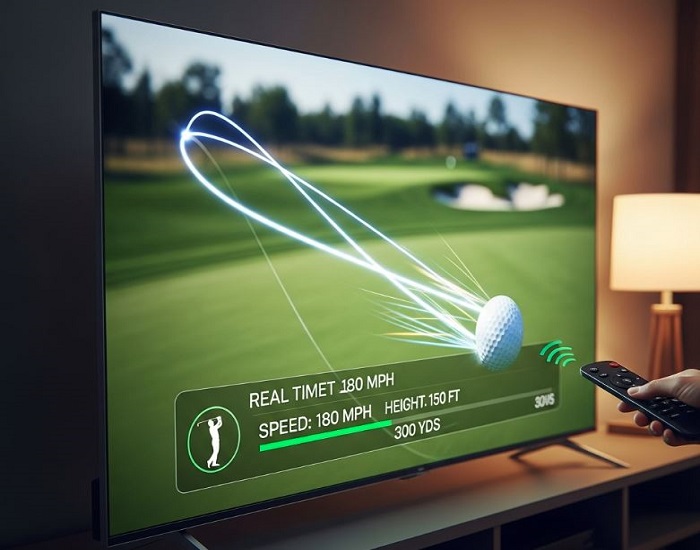Golf has long been celebrated for its precision, power, and beauty—but watching a tiny white ball fly hundreds of yards across a vast green landscape wasn’t always the easiest thing to follow on TV. So, how do they track the golf ball on TV today? Thanks to groundbreaking innovations like Toptracer, audiences now enjoy a dynamic, data-rich viewing experience.
In this guide, we’ll walk you through the step-by-step process that explains how golf ball tracking works on television. Making this once-impossible feat a high-tech reality.

Step-by-Step: How They Track the Golf Ball on TV
1st step: Multiple High-Speed Cameras Are Strategically Positioned
The magic of tracking begins before the golfer even swings. At every major broadcasted golf event, multiple high-speed, high-definition cameras are placed around the Golf Course—usually behind the tee and at key fairway angles.
- These cameras don’t just capture visuals—they collect real-time spatial data.
- Each camera is calibrated to understand depth, speed, and trajectory from its viewpoint.
2nd step: The Shot Is Captured and Tracked in Real Time
As soon as the golfer hits the ball, the cameras begin following its motion through the air.
- They record the ball’s path using a sequence of fast shutter-speed frames.
- These frames are fed into specialized tracking software that calculates position and velocity from frame to frame.
3rd step: The System Processes and Translates Data
This is where things get truly high-tech. The collected images are analyzed through a proprietary software system, like Toptracer (formerly ProTracer), to interpret the flight path.
- Algorithms calculate the speed, spin, launch angle, curvature, and apex.
- The data is turned into a 3D visual rendering almost instantly.
4rth step: The Visual Flight Path Is Rendered On-Screen
Once the software completes its calculations, it overlays the animated trajectory directly onto the broadcast footage.
- The signature colored line that tracks the ball’s flight is generated.
- This makes it much easier for viewers to follow the ball—whether it’s a 350-yard drive or a 100-yard chip.
5th step: Real-Time Shot Analytics Are Displayed
Modern systems like Toptracer don’t just show the flight—they add detailed stats on-screen.
- Metrics may include:
- Ball speed
- Launch angle
- Carry distance
- Apex height
- Shot curve
- This transforms the viewing experience from passive to interactive.
6th step: Data Is Stored for Replay and Analysis
All tracking data is stored in real-time, which allows networks to replay shots with enhanced graphics, comparisons, and slow-motion overlays.
- Commentators use this data to break down player performance.
- Fans can also see how different golfers’ shot shapes compare.
7th step: Technology Expands Beyond TV
What started as a broadcast enhancement has now become a mainstream feature in golf facilities.
- Topgolf and driving ranges now use the same Toptracer technology.
- Everyday golfers can analyze their shots the same way pros do on TV.
Technology Behind the Scenes: Toptracer vs Hawk-Eye
Toptracer operates similarly to the Hawk-Eye system used in tennis and cricket, but is tailored for golf’s unique needs.
- Developed by Swedish entrepreneur Daniel Forsgren, the tech debuted the same year Hawk-Eye appeared in the U.S. Open.
- Topgolf acquired ProTracer in 2016 and rebranded it as Toptracer.
- Today, it’s the industry standard used by networks like CBS, NBC, and Sky Sports.
Why Golf Ball Tracking Technology Matters
- Enhanced viewer experience: Viewers can follow the ball from tee to green without losing sight.
- Deeper insights: Real-time stats bring a new layer of storytelling to the game.
- Increased accessibility: Technology once reserved for elite players is now accessible to amateurs at public facilities.
Final Thoughts
So, how do they track the golf ball on TV? Through a combination of cutting-edge cameras, smart software, and real-time analytics, modern golf broadcasts have revolutionized the fan experience. What was once an invisible dot disappearing into the sky is now a vibrant arc filled with valuable insight.
As technology continues to evolve, expect even more innovations to transform how we watch and play the game.
